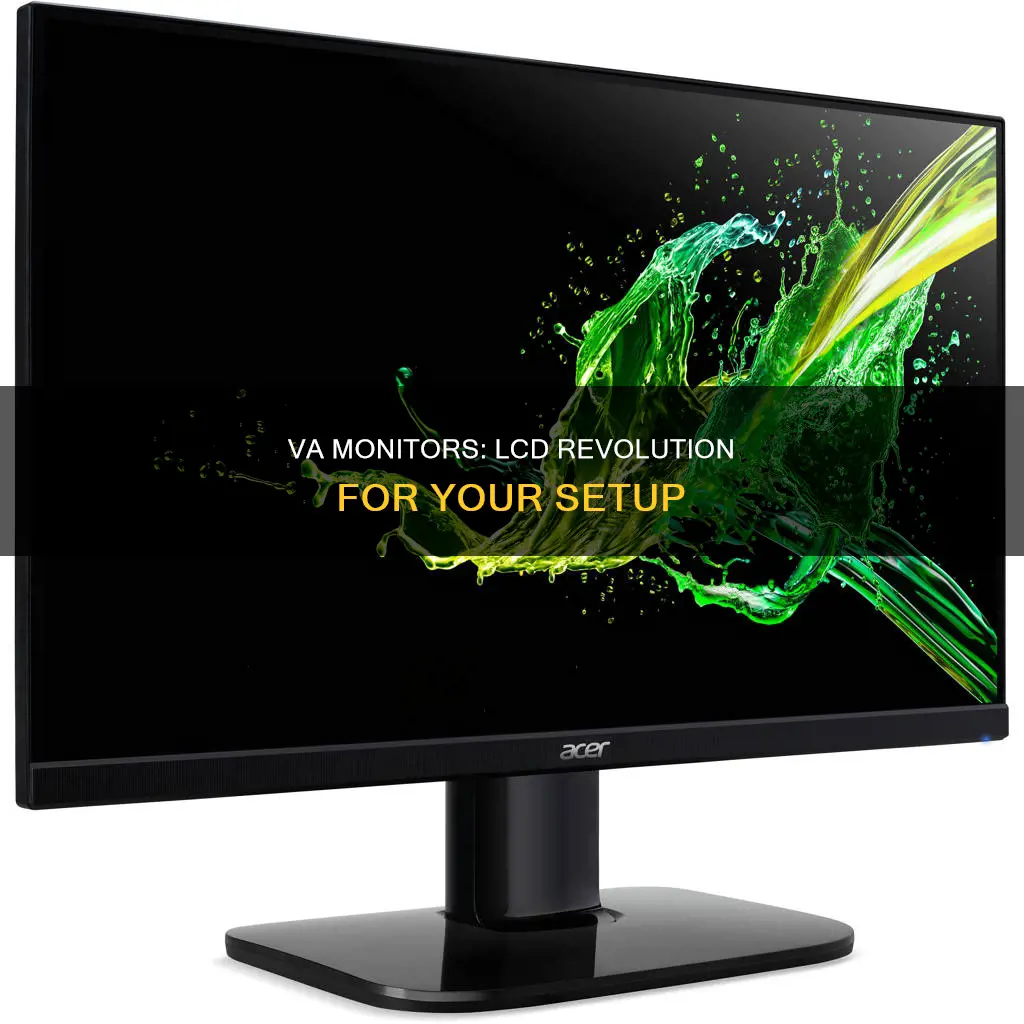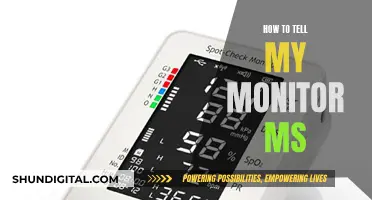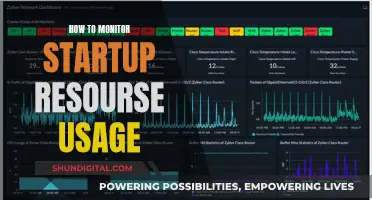
VA monitors are a type of LED monitor that stands for Vertical Alignment, with crystals that are perpendicular to the polarizers at right angles. They are known for their deep blacks, vibrant colours, and excellent contrast ratios, making them a popular choice for media consumption and gaming. VA monitors also offer improved viewing angles compared to TN monitors, which is another type of LED monitor. While VA monitors have slower response times than TN monitors, they are still a good choice for those seeking a balance between picture quality and affordability.
| Characteristics | Values |
|---|---|
| Display type | Vertical Alignment (VA) |
| LCD type | Liquid Crystal Display (LCD) |
| Backlighting | LED or CCFL |
| Colour accuracy | Excellent |
| Contrast ratio | High |
| Viewing angle | Good |
| Response time | Slower than TN |
| Motion handling | Limited |
| HDR performance | Limited |
| Cost | More expensive than TN, less costly than IPS or OLED |
What You'll Learn

VA panels have better black levels and contrast than IPS
VA panels are also superior to IPS panels when it comes to displaying deep blacks. This is due to their higher contrast ratios, which allow them to display deep blacks when viewed in the dark. IPS panels, on the other hand, tend to struggle with making the colour black, and often display it as grey. As a result, VA panels are a better choice for watching movies or playing games in dark rooms.
The superior black levels and contrast of VA panels are due to the vertical alignment of their liquid crystals. When current is not sent through them, their vertical alignment blocks light more efficiently, creating better blacks and giving better contrast.
While IPS panels have traditionally been used for displays with high colour accuracy and wide colour gamuts, VA panels have improved in this area and now offer fine colour accuracy and coverage for most users.
Replacing the LCD Monitor Cable on Your Asus Q502LA
You may want to see also

IPS panels have wider viewing angles
IPS (In-Plane Switching) panels are a specific type of LCD panel technology that offers wider viewing angles and better colour accuracy than other types of LCD technology, such as TN (Twisted Nematic) panels. IPS panels typically provide viewing angles of 178 degrees, whereas TN panels are usually limited to 160 degrees or less. This means that with an IPS panel, you can view the display from a wider range of angles without losing image quality or colour accuracy.
The wider viewing angles of IPS panels make them a popular choice for displays that will be viewed by multiple people from different angles, such as TVs or monitors used for shared viewing or gaming. IPS panels are also commonly used for photo and video editing, as their colour accuracy is important for these tasks.
In addition to wider viewing angles, IPS panels also offer improved colour accuracy and colour consistency compared to TN panels. IPS panels align liquid crystals in parallel, which results in lush colours and better black levels, viewing angles, and colour accuracy when compared to TN panels.
However, it is worth noting that IPS panels typically have slower response times than TN panels, which can be a disadvantage for gaming or other applications that require fast response times. Additionally, IPS panels may struggle with displaying true black colours, as they tend to crush black levels. Despite these limitations, IPS panels remain a popular choice for many applications due to their superior viewing angles and colour accuracy.
Monitoring IO Usage: Linux Tips and Tricks
You may want to see also

VA panels are better for gaming
VA panels are a great choice for gaming, offering excellent contrast ratios, colour reproduction, and viewing angles.
VA stands for Vertical Alignment, and these monitors are a type of LED monitor that uses crystals that are perpendicular to the polarizers at right angles. This technology is similar to that used in TN (twisted nematic) monitors, but VA panels offer superior viewing angles, colour accuracy, and contrast ratios.
VA panels are known for their deep blacks and vibrant colours, making them a popular choice for gaming and media consumption. They offer a balance between good picture quality and affordability. While they may not be the fastest option, they are still suitable for most gaming needs, with response times of 2-3ms and refresh rates of 200Hz.
When it comes to contrast ratios, VA panels are second only to OLED, with ratios of 3000:1 and higher. This means that VA panels can display deep blacks and enhance your gaming experience, especially in darker scenes.
VA panels also offer improved viewing angles compared to TN monitors, ensuring consistent picture quality when viewed from different angles. While IPS (In-Plane Switching) panels offer wider viewing angles, VA panels still provide a good balance, making them suitable for multi-monitor gaming setups.
In summary, VA panels offer a great balance of features for gaming, including excellent contrast ratios, colour accuracy, and good viewing angles. They are a popular choice for gamers who want a versatile monitor with high-quality visuals without breaking the bank.
Activity Monitor Data Usage: A 24-Hour Watch
You may want to see also

IPS panels have better colour accuracy
IPS (In-Plane Switching) panels offer the most accurate and consistent colours, with wider viewing angles than VA panels. This means that you can look at the screen from any angle without the image shifting in colour or contrast. This is particularly important for designers and photographers, who need to be able to trust that the colours they see on screen are accurate.
IPS panels have a more linear response than TN and MVA panels, and higher bit depth (8-bit or 10-bit panels). They also have better contrast and consistency across a range of viewing angles, and can reproduce 8-bit colour (256 shades of each primary colour) naturally, without blending 6-bit colours.
IPS panels also have a larger colour gamut, or range of colours they can display. While no monitors on the market are capable of displaying the entire gamut of colours humans can see, IPS panels get closer than VA panels.
IPS panels are also more affordable than VA panels, with some IPS monitors only slightly more costly than their VA counterparts.
Monitoring Children's Internet Usage: Parenting or Invasion?
You may want to see also

VA panels are more common in TVs
VA panels are therefore better for watching movies in dark rooms as they can display deep blacks, while IPS panels tend to make blacks appear grey. This is despite the fact that IPS panels offer wider viewing angles and more accurate colours. This means that IPS panels are more suitable for group viewings, where viewers may be sitting at an off-angle, or for use as a PC monitor, where the edges of the screen can be seen clearly from up close.
While VA panels are more common in TVs, IPS panels are still common in computer monitors, where their wider viewing angles are beneficial.
Is Your App Usage Being Monitored? Here's How to Know
You may want to see also
Frequently asked questions
VA stands for Vertical Alignment. VA panels are a common type of LED monitor that features excellent contrast ratios, colour reproduction, and viewing angles.
LCD stands for Liquid Crystal Display. LCDs use liquid crystals that alter the light to generate a specific colour. As such, some form of backlighting is necessary, usually LED.
VA monitors are a type of LED monitor, and LED is a type of backlighting used in LCD monitors. So, VA monitors are a subset of LCD monitors.
VA monitors have better contrast ratios and colour accuracy, but LCD monitors have wider viewing angles. The best option depends on your specific needs.







